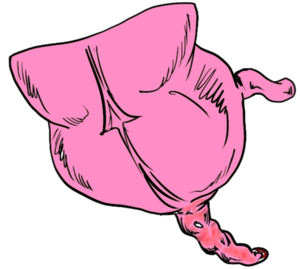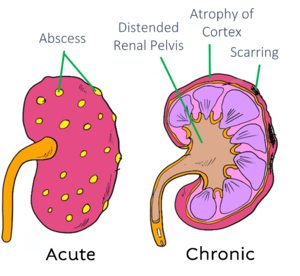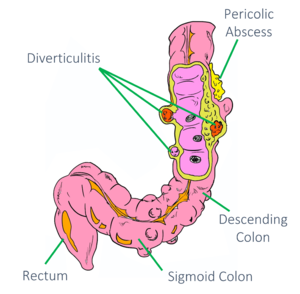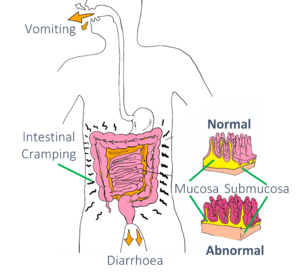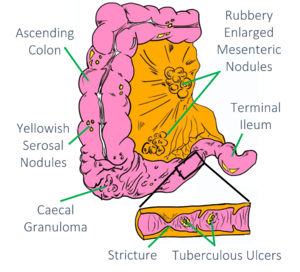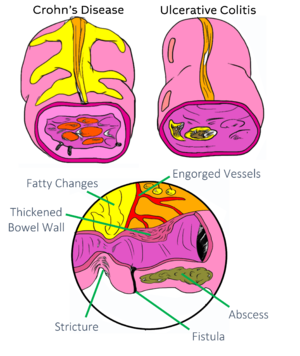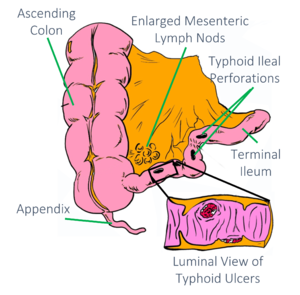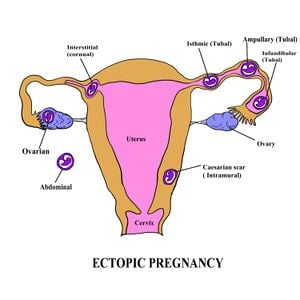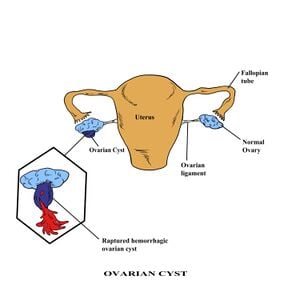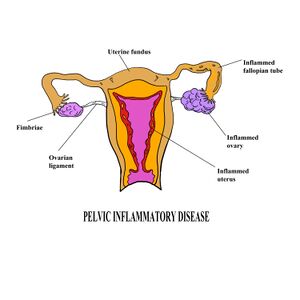Pyelonephritis in an ascending infection of the upper urinary tract, specifically the renal parenchyma and renal pelvis. Pyelonephritis can be acute or chronic. If not treated it can lead to sepsis and renal abscesses and may cause secondary hypertension and renal failure. Unlike appendicitis, pyelonephritis presents more commonly in women due to shorter urethra and the urine analysis would demonstrate pyuria and bacteriuria.
Diverticulitis is an inflammation of an outpouching of the sigmoid colon that often presents with left lower quadrant pain and fever. However, people of Asian and African descent have redundant sigmoid colons, meaning the sigmoid colon may sweep all the way to the right side of the abdomen. When these individuals have diverticulitis, they may present with right lower quadrant pain. Similar to appendicitis, the labs are nonspecific and the patient may have rebound and guarding. Diverticulitis, however, most often occurs in the sigmoid colon and as such, presents with left sided abdominal pain.
Gastroenteritis, also known as infectious diarrhea is inflammation of the gastrointestinal tract caused most commonly by viruses, but can also be due to bacteria, parasites and fungus. Patients typically present with generalized cramping, abdominal pain, diarrhea, vomiting and anorexia. Unlike in appendicitis, the patient's contacts and diets become important. Patients are typically exposed to a sick contact or contaminated food prior to developing symptoms.
Gastrointestinal Tuberculosis is a type of extrapulmonary tuberculosis that typically presents with pulmonary symptoms, but rarely may present alone. It accounts for 1-3% of the tuberculosis cases worldwide. Patients may have a subacute presentation with generalized abdominal pain that can mimic acute appendicitis. However, patients with gastrointestinal tuberculosis are likely to have systemic symptoms including hepatosplenomegaly, weight loss or lymphadenopathy. Patients may have a tuberculosis-associated perforation or obstruction. If surgical intervention is necessary, a right lower quadrant incision is NOT recommended because the whole bowel needs to be assessed.
The principal types of inflammatory bowel disease are Crohn's disease (affecting the small intestine and large intestine, as well as the mouth, esophagus, stomach and the anus) and ulcerative colitis (primarily affecting the colon and rectum). Symptoms of Inflammatory bowel disease include, abdominal pain, diarrhea, rectal bleeding, severe abdominal cramps and weight loss. Unlike patients with appendicitis, patients with inflammatory bowel disease will have more than just abdominal pain.
Typhoid is a bacterial infection caused by the Salmonella serotype Typhi bacteria. It is spread by eating food or drinking water contaminated with the feces from an infected person. Symptoms include high fever, diarrhea and vomiting. One in ten patients may have an urgent complication including perforation of intestinal ulcers. Patients may have perforated ulcers that require a surgical intervention. Unlike appendicitis, patients with typhoid ulcers present with a delayed peritoneal response. If surgical intervention is necessary, a right lower quadrant incision is NOT recommended because the entire bowel should be assessed for typhoid lesions.
When a fertilized egg grows outside of the uterus. With 9 out of 10 times, the fertilized egg is within the fallopian tube. This can be challenging to differentiate from appendicitis. In all female patients of child-bearing age, obtain a pregnancy test. If the patient has a positive pregnancy test, obtain a right lower quadrant ultrasound.
Ovarian torsion results from twisting of the ovary on the supporting ligaments. Patient typically present with acute onset lower abdominal pain. These patients typically have an underlying pathology. Like appendicitis, this pathology would benefit from surgical intervention. However, to prevent the incorrect incision, an ultrasound with doppler can demonstrate the ovary with impaired blood flow.
PID may present with fever and lower abdominal pain with possible additional symptoms relating to the urogenital tract. To differentiate from appendicitis, a thorough history from the patient must be obtained including sexual history. Patient may have cervical motion tenderness on vaginal exam.
